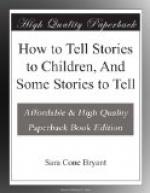Sometimes, to be sure, a side remark adds piquancy and a personal savour. But the general rule is, great discretion in this respect.
Every epithet or adjective beyond what is needed to give the image, is a five-barred gate in the path of the eager mind travelling to a climax.
Explanations and moralising are usually sheer clatter. Some few stories necessarily include a little explanation, and stories of the fable order may quaintly end with an obvious moral. But here again, the rule is—great discretion.
It is well to remember that you have one great advantage over the writer of stories. The writer must present a clear image and make a vivid impression,—all with words. The teller has face, and voice, and body to do it with. The teller needs, consequently, but one swiftly incisive verb to the writer’s two; but one expressive adjective to his three. Often, indeed, a pause and an expressive gesture do the whole thing.
It may be said here that it is a good trick of description to repeat an epithet or phrase once used, when referring again to the same thing. The recurrent adjectives of Homer were the device of one who entertained a childlike audience. His trick is unconscious and instinctive with people who have a natural gift for children’s stories. Of course this matter also demands common sense in the degree of its use; in moderation it is a most successful device.
Brevity, close logical sequence, exclusion of foreign matter, unhesitant speech,—to use these is to tell a story directly.
After simplicity and directness, comes that quality which to advise, is to become a rock of offence to many. It is the suggestion, “Tell the story dramatically.” Yet when we quite understand each other as to the meaning of “dramatically,” I think you will agree with me that a good story-teller includes this in his qualities of manner. It means, not in the manner of the elocutionist, not excitably, not any of the things which are incompatible with simplicity and sincerity; but with a whole-hearted throwing of oneself into the game, which identifies one in a manner with the character or situation of the moment. It means responsively, vividly, without interposing a blank wall of solid self between the drama of the tale and the mind’s eye of the audience.
It is such fun, pure and simple, so to throw oneself into it, and to see the answering expressions mimic one’s own, that it seems superfluous to urge it. Yet many persons do find it difficult. The instant, slight but suggestive change of voice, the use of onomatopoetic words, the response of eyes and hands, which are all immediate and spontaneous with some temperaments, are to others a matter of shamefacedness and labour. To those, to all who are not by nature bodily expressive, I would reiterate the injunction already given,—not to pretend. Do nothing you cannot do naturally and happily. But lay your stress on the inner and spiritual effort to appreciate, to feel, to imagine out the tale; and let the expressiveness of your body grow gradually with the increasing freedom from crippling self-consciousness. The physique will become more mobile as the emotion does.




